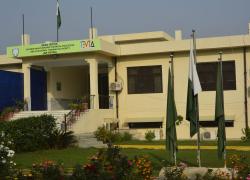Digitalization of the Universities: A tall order for the academic leadership
The last two decades witnessed exponential growth in the higher education sector in Pakistan. The landscape of HE, science and technology in the country has transformed in an unprecedented manner. The rapid developments made during the period was breathtaking. The number of universities increased multiple times. The existing ones were strengthened. New campuses were established. New research centers were set up. The number of students enrolled in the HEIs increased manifold. The number of graduates produced by these universities multiplied. However, one particular area that received minimal attention was the digitalization of internal systems and processes of the universities.
This blog post takes a look at the background of the digitalization initiatives in the public sector universities in Pakistan, how much ground has been covered, major bottlenecks and challenges faced by the universities in going digital and what needs to be done by the universities to digitalize its official business.
Background of the digitalization initiatives in the universities
Historically, public sector universities feature an exceedingly low level of automation. The bulge of the official business and a huge portion of the internal processes are taken on manually. The internal functions, tasks and operations, in a wide variety of cases are laborious, time-consuming and complex. Through Proper Channel is still the prevailing norm in the official business in the universities. To digitalize internal systems, sub-systems and processes remained a low priority area in the entire public sector, let alone the universities.
Emerging bottlenecks in the online classes in the universities
There prevails a disappointing disparity among various universities in terms of digitalization. Though in some universities online classes were launched in the wake of corona pandemic, nevertheless, insufficient digital infrastructure, the dearth of capacity building of the faculty and students to use online resources, connectivity issues, power outage and costly subscription to the required softwares were some of the common bottlenecks. Though some of the urban universities responded promptly and proactively to the call, however, HEIs having students’ concentration from rural areas and remote parts were struggling to catch up with. Despite numerous hurdles, it is encouraging to see universities are shifting to the new mode of delivery.
The new digitalization initiatives of the universities
Another encouraging thing, some universities have already embarked on digitalizing administrative functions as well as official business sooner it was realized that working from home/station was not plain sailing as the official business, predominately the file system, academic functions, research, financial management, HR, and other core areas have not been automated.
Some universities such Khyber Medical Univerity Peshawar, University of Peshawar, UET Peshawar, COMSATS, NUST, QAU, University of Haripur, LUMS, Virtual University and AIOU have already taken similar bold initiatives towards digitalization. However, each one of these is working in complete isolation. Besides, some of these are focusing on one particular domain/aspect while others are fixing some other areas.
Major challenges in going digital
Automation of public sector educational institutions remained challenging for a variety of reasons. These include but not limited to lack of continuous support from the top leadership, misplaced priorities, lack of understanding of its significance, financial constraints, resistance to change, implementation & its maintenance and reluctance to embrace new ways of managing official business.
The outcome of digitalization in the universities
Available literature in the field of public sector automation suggests that such initiatives always pay off. It is destined to bring efficiency, eradicate red-tap, do away with academic dishonesty, wipe-out mal-practices and overcome inadvertent delay in disposing-off official business which is a trademark of the current manual system in the universities in Pakistan.
Recommendations
The Corona pandemic provided a unique opportunity for the universities to adopt a virtual office environment (e-office) and make it possible to perform official business from home. With the growing evidence that we must live with COVID-19 for a foreseeable future, the universities in Pakistan have no other option but to digitalize its systems, functions and processes.
This demands urgent attention of the top academic leadership. The management has to give serious consideration to this out-rightly neglected aspect of the higher education sector in the country. Collaboration among the academic institutes shall be helpful in saving time, energy and resources. It is also proposed that the universities should move towards outsourcing, integrated solutions and allow others to learn from their experiences.















